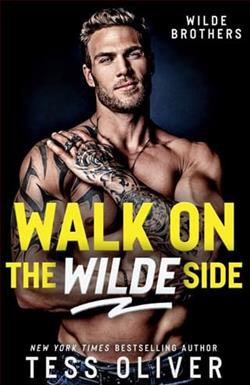Page 150 of Final Justice (Badge of Honor 8)
“I’m yours! And I love your imagination.”
“I feel like putting my arms around you and holding you and telling you that everything’s going to be all right.”
“That isn’t exactly what I thought you had in mind.”
“Can I?” Olivia asked.
“Yeah,” he said after a moment.
She leaned toward him and he half sat up, and she put her arms around him and held him to her breast.
They stayed that way for perhaps three minutes, and then Olivia glanced down at the sheet covering his groin.
“You horny sonofabitch,” she said, wonderingly.
“Is that a complaint?”
She pushed him away from her breast and back onto the bed and looked down at him for a moment before shaking her head, “no.”
Fifteen minutes later, they got into the unmarked Crown Victoria and rode out to the Northeast Detectives Division and gave their statements.
THIRTEEN
J. Richard Candelle, a squat, gray-haired fifty-year-old black man who wore his frameless spectacles low on his nose, looked over them at Detective Tony Harris, backed against a laboratory table, shook his head, and announced, “Tony, I’m sorry, that’s the best I can do. There’s just not enough points.”
The reality of identification through fingerprints is not nearly as simple, or as easy, as a thousand cops-and-robbers movies have made the public-and, in fact, a surprising number of law enforcement officers-think it is.
Fingerprints are identified-and compared with others- through a system of point location, and the classification of these points. The more points on a print, the better. The more prints-prints of more than one finger, of the heel of the hand, or ten fingers and both heels-and the more classified points on each print, the easier it is to find similarly classified prints in the files.
Presupposing having both to compare, comparing the print found on the visor hat left behind by the doer at the Roy Rogers restaurant with the print of the doer himself would be relatively simple and would just about positively identify the suspect.
But establishing the identity of the doer by finding a match of his index-finger print among the hundreds of thousands of index-finger prints in the files of the Philadelphia police department, or the millions in the FBI’s files, was a practical impossibility.
Except, if a print could be obtained with many “good” points, that could be point classified.
J. Richard Candelle, Philadelphia’s fingerprint expert, had just not been able to detect enough points on the single index finger print he had to offer even a slight chance of matching it with a print in the files.
“Fuck, that’s not good enough,” Harris said, bitterly.
“I will elect not to consider that a personal criticism, and under these circumstances forgive your vulgarity.” Candelle, whose forensic laboratory skills were legendary, was a dignified man, befitting his part-time status as an adjunct professor of chemistry at Temple University.
“It wasn’t a s
hot at you, Dick, and you know it,” Harris said.
Candelle waited until he saw what he thought was a genuine look of regret on Harris’s face, and then went on:
“I was here all fucking night, Tony. I had two fucking doughnuts for breakfast, my fucking feet hurt, and I have had every fucking white shirt in the Roundhouse in here making sure I was really doing my fucking best.”
Harris looked at him.
“Well, in that case, you fucking overworked old fart, I guess I better buy you some fucking lunch before you fucking expire of starvation, old age, and self-pity right here in the fucking lab.”
“I think that would be an appropriate gesture of your gratitude, ” Candelle replied, smiled, and started to replace his laboratory coat with a sports coat.
Using tweezers, Candelle picked up the crownless visor cap the doer had left behind in the Roy Rogers and replaced it in the plastic evidence bag.
“You want me to hang on to this, Tony?”















